ABSTRACT
Background
Meha Mudgara Rasa (MMR) is a classical Ayurvedic herbo-mineral formulation that is traditionally used in the management of diabetes. Despite its long-standing therapeutic use, scientific validation of its pharmacognostic profile and its antidiabetic efficacy is limited. This study aimed to evaluate the phytochemical composition and antidiabetic potential of MMR using modern analytical techniques.
Materials and Methods
Raw materials for Meha Mudgara Rasa were verified as per Ayurvedic Pharmacopoeia. Kanta Loha Bhasma was subjected to Amruteekaran and Puta. The drug was formulated through classical process with trituration, Bhavana by Triphala decoction, and tablet making. Physicochemical values (e.g., hardness, disintegration, ash values) were evaluated. Methanolic extracts were analyzed using High-Performance Thin-Layer Chromatography (HPTLC) for phytochemical fingerprints.
Results
The tablets were black with typical taste and smell. Physicochemical evaluation validated conformance with pharmacopoeial requirements. HPTLC showed clear chromatographic fingerprints at 254 nm and 366 nm, and identification of bioactive compounds using Rf values and comparison to PubChem.
Conclusion
This study supports the traditional use of Meha Mudgara Rasa in the management of diabetes. Its therapeutic effects may be attributed to the synergistic action of its phytochemical constituents. Further pharmacological and clinical studies are warranted to elucidate its mechanisms and confirm its clinical applicability.
INTRODUCTION
With increasing global interest in Ayurvedic traditional medicines, there is a corresponding need to ensure their safety, purity, and therapeutic efficacy. This growing demand places critical responsibility on pharmaceutical manufacturers and regulatory authorities to implement stringent standardisation (Jahanet al., 2018). Drug standardisation encompasses the evaluation of multiple parameters, including phytochemical profiling and physicochemical characterization, which are essential for confirming the identity, quality, and efficacy of Ayurvedic formulations.
Diabetic neuropathy is a prevalent complication of diabetes mellitus and is characterized by peripheral nerve damage due to microvascular dysfunction affecting the vasa nervorum. Among its various forms, distal symmetric polyneuropathy is the most common and involves Type A and Type C nerve fibers. It often remains underdiagnosed, particularly in asymptomatic or painless cases, leading to significant morbidity. The pathological features include distal motor axonal loss, diminished nerve conduction velocity, and degeneration of small and large myelinated as well as unmyelinated sensory fibers. Clinically, it presents with symptoms such as numbness, paresthesia, burning sensations, muscle weakness, reduced reflexes, and impaired coordination-often with nocturnal exacerbation.
Meha Mudgara Rasa is a classical Ayurvedic herbomineral formulation cited in Bhaishajya Ratnavali under Prameha Rogadhikar (Diabetes) (Sivakumaret al., 2022). It contains 14 medicinal herbs and one mineral ingredient. Notably, components such as Dadima (Punica granatum) (Alharthy et al., 2023). Triphala (Ariya et al., 2006), Bilva (Aegle marmelos) (Sayeed et al., 2016), and Gokshura (Tribulus terrestris) (Caporali et al., 2022) have demonstrated antidiabetic, hypolipidemic, and neuroprotective properties in pharmacological studies. These phytotherapeutic actions suggest a potential role for Meha Mudgara Rasa in modulating the pathophysiological mechanisms underlying diabetic neuropathy. Its use may contribute to the management of both peripheral vascular and neuronal complications associated with diabetes.
MATERIALS AND METHODS
Collection and Authentication of Ingredients
Raw materials of Meha Mudgara Rasa were procured from an authorized Ayurvedic pharmacy and authenticated by the Dravyaguna department as per API standards (Table 1).
| Sl. No. | Ingredients | Part used | Quantity |
|---|---|---|---|
| 1. | Amalaki (Embilica officinalis L.) | Fruit | 1 part |
| 2. | Bibhitaki (Terminalia billerica Roxb.) | Fruit | |
| 3. | Haritaki (Terminalia chebula Retz.) | Fruit | |
| 4. | Rasanjan (Berberis aristate DC.) | Root | 1 part |
| 5. | Devdaru (Cedrus deodara Roxb.) | Leaves, Bark | 1 part |
| 6. | Bilva (Aegle marmelos C.) | Fruit | 1 part |
| 7. | Gokshura (Tribulus terrestris Linn.) | Fruit | 1 part |
| 8. | Dadima (Punica granatum Linn.) | Fruit | 1 part |
| 9. | Bhunimba (Swertia chirayita Roxb.) | Whole Plant | 1 part |
| 10. | Pippali (Piper longum L.) | Fruit | 1 part |
| 11. | Sunthi (Zingiber officinale Roscae.) | Stem | |
| 12. | Maricha (Piper nigrum Linn.) | Fruit | |
| 13. | Trivruta (Operculina terpethum Linn.) | Root bark | 1 part |
| 14. | Guggulu (Commiphora wightii Arnott.) | Extract | 4 parts |
| 15. | Loha Bhasma | 15parts |
Authentication of Bhasma
Kanta Loha Bhasma was evaluated as per the Pharmacopoeial Standards for Ayurvedic Formulations (PSAF) and the Ayurvedic Pharmacopoeia of India (API) standards (Table 2).
| Sl. No. | Parameters | Kant Loha Bhasma |
|---|---|---|
| 1 | Characteristic | Soft and Lusterless |
| 2 | Color | Red |
| 3 | Magnetic Test | Negative |
| 4 | Limit Test | Ferrous sulphate (FeS) is found |
Method of Preparation
Amruteekaran
Amruteekaran is a process adopted to remove residual toxins and enhance the therapeutic action of drugs. First, the Amruteekaran of Kanta Loha Bhasma was performed as classically mentioned by trituration with a decoction of Triphala and subjected to 1 Puta (800ºC for 3 hr) in an electric muffle furnace.
All the fine powders of the herbal drugs are mixed properly in an end-runner machine.
Guggulu is purified and dissolved in Triphala Kashaya, which is used as Bhavana Dravya and mixed with fine powders of herbal drugs.
These mixtures were mixed with Kanta Loha Bhasma processed for 6 hr and dried in a tray-dried machine.
After proper drying, granules are made in the granulator machine, and a binding agent such as starch is added at a ratio of 1:10 to make tablets in a multiple tablet punching machine.
Analytical parameters
Physiochemical characterization of Meha Mudgara rasa tablets was performed, assessing hardness, friability, pH, ash values, disintegration time, loss on drying, acid-insoluble ash, and extraction values, following the Ayurvedic Pharmacopoeia of India (API) and Indian Pharmacopoeia (IP) standards.
High-Performance Thin-Layer Chromatography (HPTLC)
To evaluate its phytochemical profile, the Meha Mudgara rasa methanolic extract was analysed using HPTLC.
Preparation of Test Solution
The sample (5 g) was weighed, and 100 mL of methanol was added. The mixture was sonicated for 15 min and filtered with simple filter paper. The filtrate was used as a test solution and thus obtained for HPTLC fingerprinting. The details of the HPTLC conditions are outlined in Table 3.
| Chromatographic Conditions: | |
|---|---|
| Application Mode | CAMAG Linomat 5 (S/N: 280008) Applicator |
| Filtering System | Simple filter |
| Stationary Phase | MERCK – HPTLC Silica gel 60 F254 on Aluminum sheets |
| Application (Y axis) Start Position | 8.0 mm |
| Development End Position | 80 mm from the plate base |
| Sample Application Volume | 15 µL |
| Distance Between Tracks | 13.4 mm |
| Development Mode | CAMAG TLC Twin Trough Chamber |
| Chamber Saturation Time | 20 min |
| Mobile Phase (MP) | Toluene: Ethyl acetate methanol (7.5:1.5:0.75v/v/v) |
| Visualization | @ 254 nm and @366 nm |
| Drying Mode, Temp. and Time | At room temperature for 5 min |
OBSERVATIONS AND RESULTS
Macroscopic analysis
The tablets were black. It has a characteristic taste and aromatic odor.
Organoleptic evaluation
The organoleptic analysis was performed as follows (Table 4).
| Sl. No. | Parameters | Result |
|---|---|---|
| 1 | Odor | Slightly aromatic |
| 2 | Color | Black |
| 3 | Taste | Characteristic |
| 4 | Consistency | Solid |
Physicochemical analysis
The observations of various physicochemical analyses are mentioned below (Table 5).
| Sl. No. | Parameters | Result | Normal Range |
|---|---|---|---|
| 1 | pH | 6.8 | 5.5-7.5 |
| 2 | Loss on drying at 110 c (%w/w) | 8.88 | ≤ 15% |
| 3 | Total Ash (%w/w) | 34.19 | ≤ 10% |
| 4 | Acid insoluble ash (%w/w) | 28.6gms | (Variable) |
| 5 | Water soluble extractive (%w/w) | 41.7 | 15-30% |
| 6 | Alcohol soluble extractive (%w/w) | 4.5 | 20-40% |
| 7 | Average tablet weight (gm) | 0.687 | – |
| 8 | Highest weight (gm) | 0.759 | – |
| 9 | Lowest weight (gm) | 0.602 | – |
| 10 | Tablet hardness (Kg/cm2) | 6.8 | 4-12 |
| 11 | Friability test (%) | 21.46 | ≤ 2% |
| 12 | Disintegration time (mins) | 08 | (Variable) |
HPTLC Analysis
HPTLC analysis was performed at wavelengths of 254 nm and 366 nm with sample volumes of 10.0 µL, 15.0 µL, and 20.0 µL. Chromatographs at 254 nm are shown in Figures 1–3, while Figure 4 depicts the chromatograph at 366 nm using 20.0 µL. The Rf values, fingerprint profiles, peak heights, and percentage areas were recorded. Chemical substances were identified by comparing these results with PubChem data, with detailed findings and bioactivities presented in Tables 6–9 [Source: PubChem, Google Scholar].
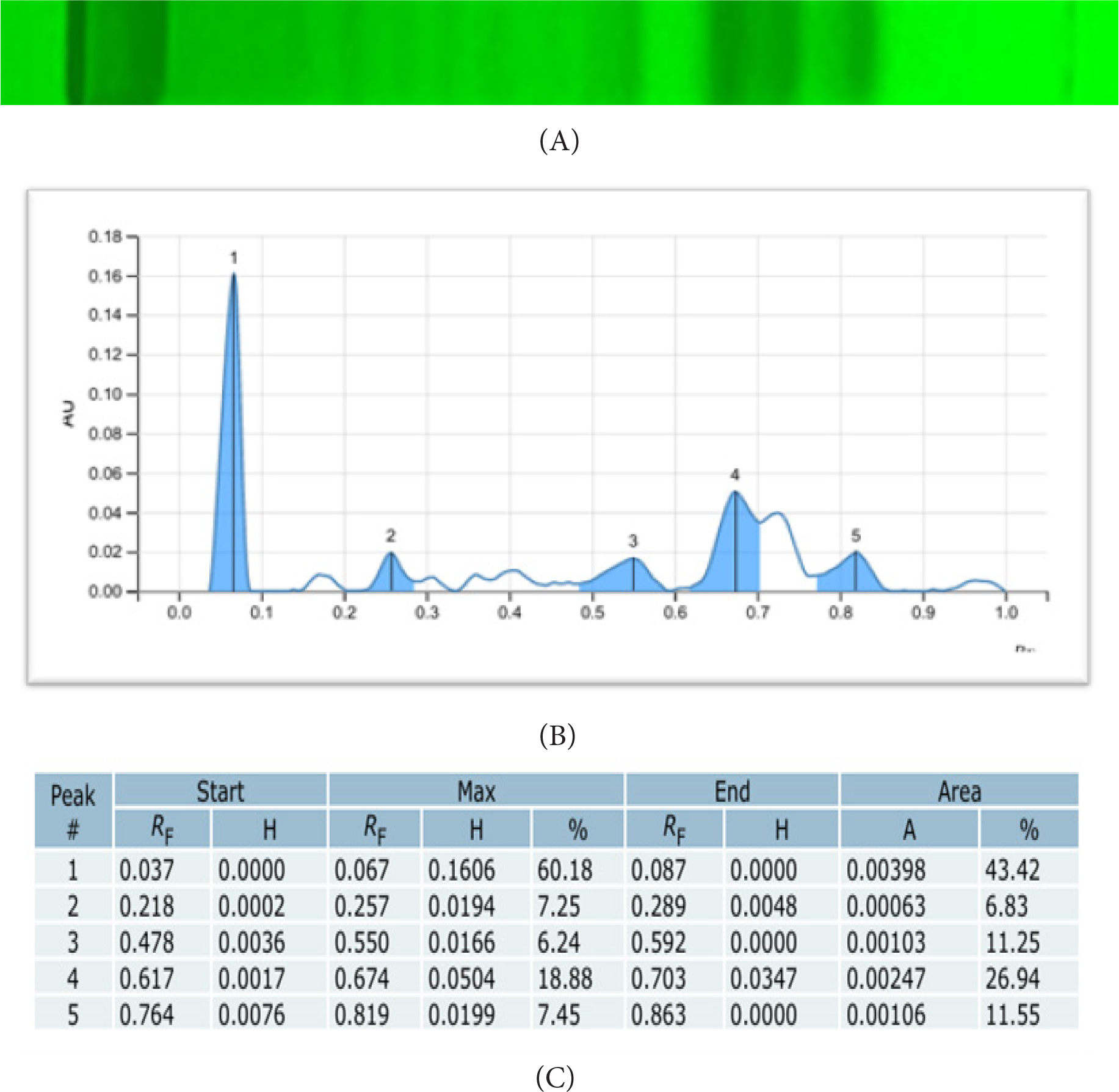
Figure 1:
HPTLC Chromatograph of Meha Mudgara rasa @254 nm and a volume of 5.0 µL (A=Fingerprint, B= Peak height, C= Rf value and area percentage) (A)
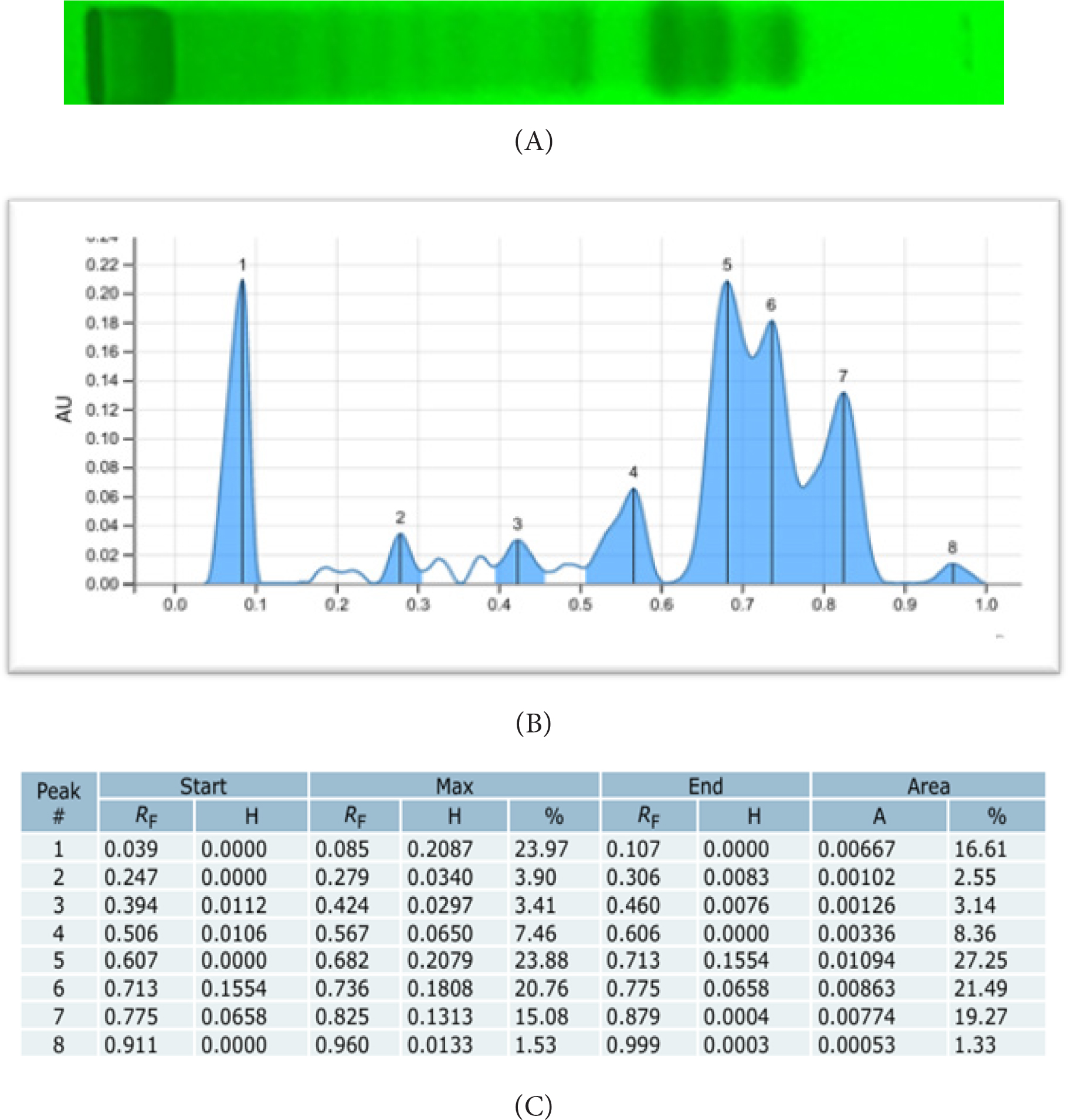
Figure 2:
HPTLC Chromatograph of Meha Mudgara rasa @254 nm and 10.0 µL volume (A=Fingerprint, B= Peak height, C= Rf value and area percentage). (A)
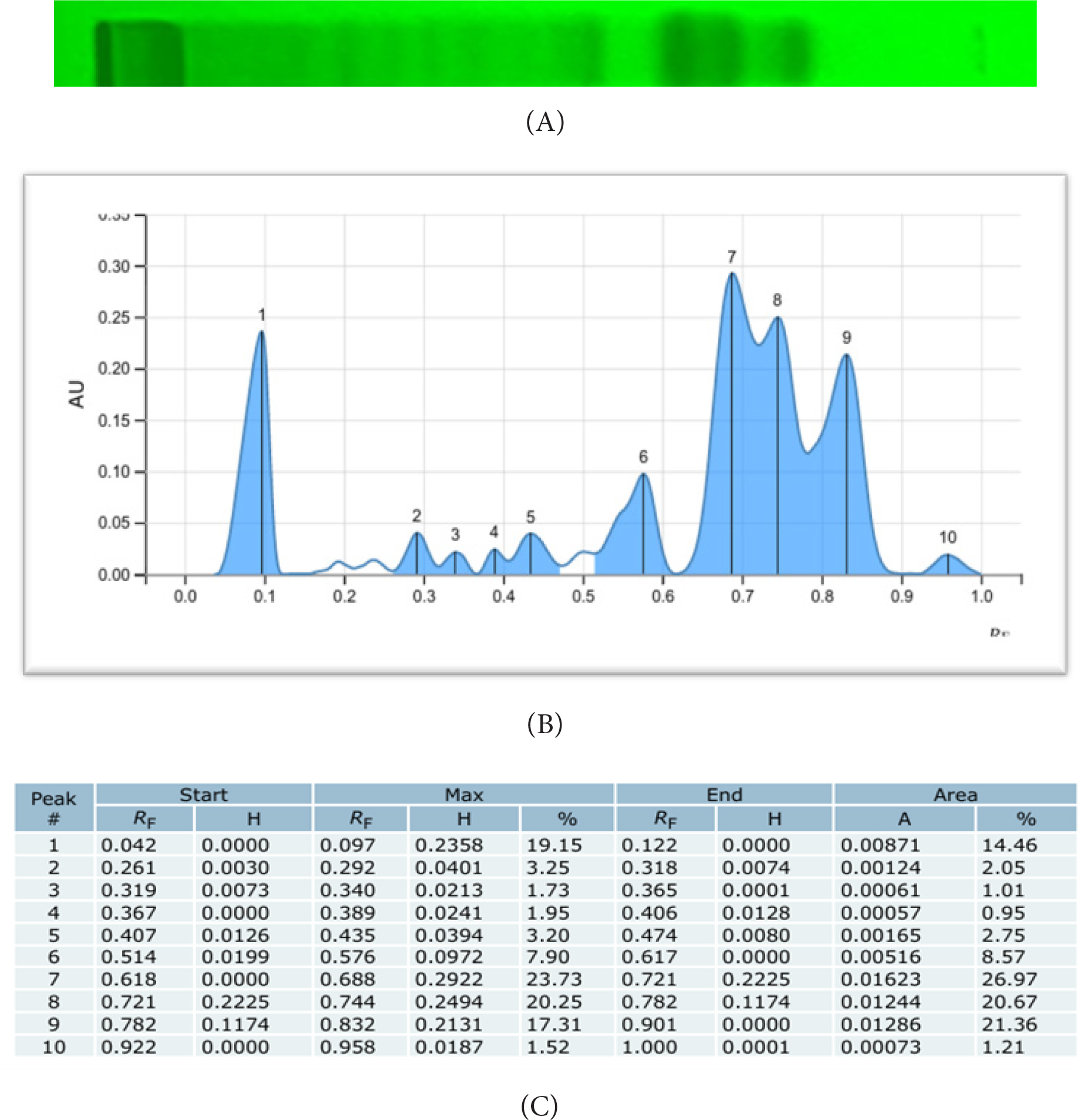
Figure 3:
HPTLC Chromatograph of Meha Mudgara rasa @254 nm and 15.0 µL volume (A=Fingerprint, B= Peak height, C= Rf value and area percentage. (A)
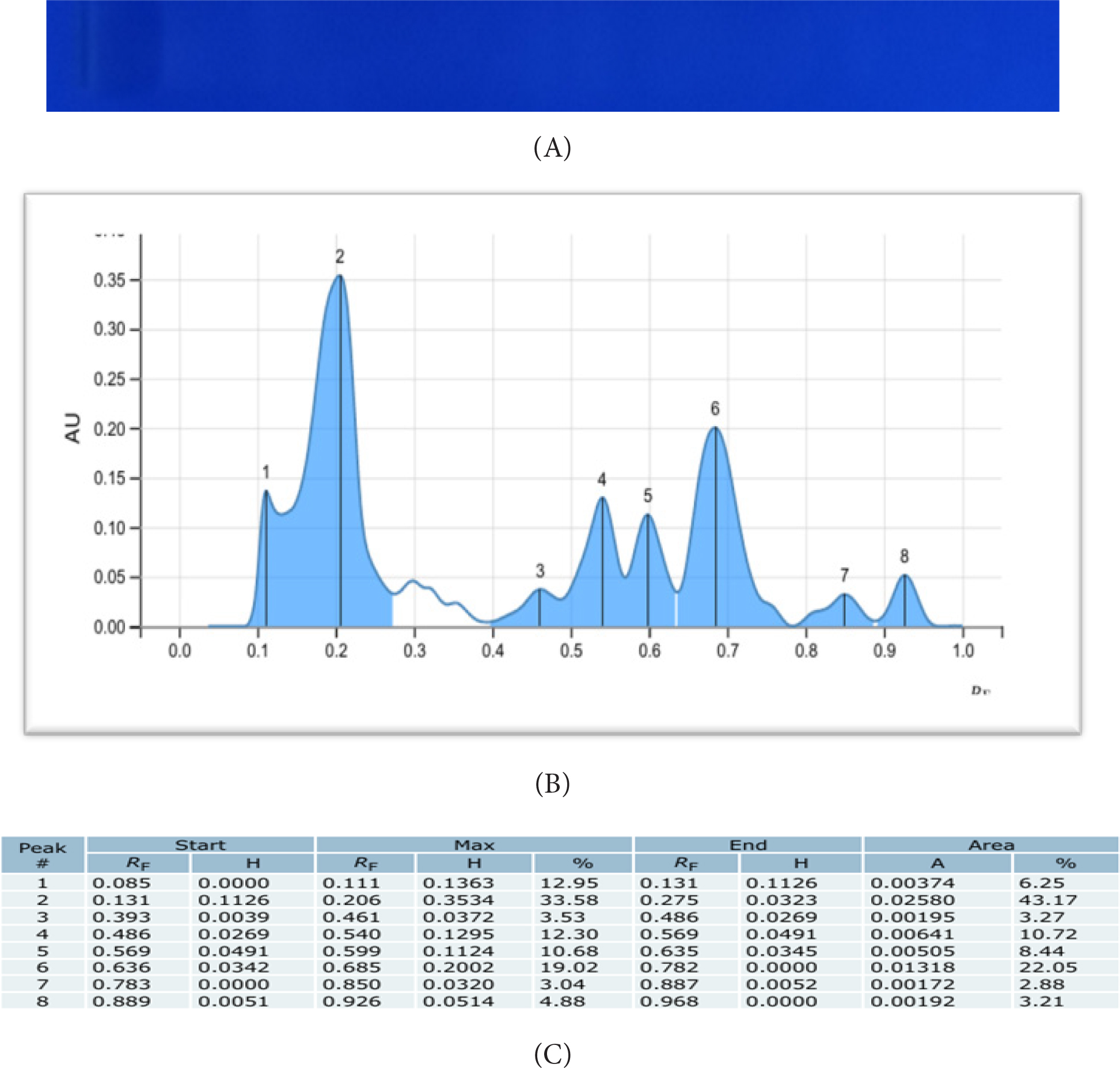
Figure 4:
HPTLC Chromatograph of Meha Mudgara rasa @366 nm and 15.0 µL volume (A=Fingerprint, B= Peak height, C= Rf value and area percentage).
| Max Peak | Rf value | Area of Percentage | Phytoconstituents [PubChem, Google Scholar] |
|---|---|---|---|
| 1. | 0.067 | 60.18% | Quercetin – Antioxidant, Anti-inflammatory, and neuroprotective (Sousaet al., 2018). |
| 2. | 0.257 | 7.25% | Volatile oil (Linalool) – Antioxidant, Anti-inflammatory, Analgesic (Dhimanet al., 2022). |
| 3. | 0.550 | 6.24% | Alkaloids (Piperitone)- antioxidant, anticancer, anti-inflammatory, antihypertensive, hepatoprotective, and neuroprotective (Dhundhuk Nath, n.d.). |
| 4. | 0.674 | 18.88% | Myristicin- Antidiabetic, Antioxidant, B-cell regeneration (Gautam and Ramanathan, 2019). |
| 5. | 0.819 | 7.45% | Umbelliferone -inhibition of oxidative stress, inflammation, and apoptosis, improvement of insulin resistance, myocardial hypertrophy, and tissue fibrosis, in addition to regulation of blood glucose and lipid metabolism (Ginwalaet al., 2019). |
| Max Peak | Rf value | Area of Percentage | Phytoconstituents [PubChem, Google Scholar] |
|---|---|---|---|
| 1. | 0.085 | 23.97% | Terpenes (Linanyl acetate)- Antioxidant, Anti-inflammatory (Jain et al., 2013). |
| 2. | 0.279 | 3.90% | Menthol derivatives (Ajmaline) – Anti-arrhythmic (Kamalakkannan and Prince, 2004). |
| 3. | 0.424 | 3.41% | Carvone -Antidiabetic (Kim et al., 2016). |
| 4. | 0.567 | 7.46% | Apigenin – Antidiabetic, Neuroprotective, Anti-inflammatory (Kumar and Pandey, 2013). |
| 5. | 0.682 | 23.76% | Luteolin 7 – Glucoside -Anti-inflammatory, Antidiabetic, Hypolipidemic (Lin et al., 2023). |
| 6. | 0.736 | 20.76% | Coumarin – Anti-allodynic (Maharaj and Rohan, 2013). |
| 7. | 0.825 | 15.08% | Umbelliferone -inhibition of oxidative stress, inflammation, and apoptosis, improvement of insulin resistance, myocardial hypertrophy, and tissue fibrosis, in addition to regulation of blood glucose and lipid metabolism (Ginwala et al., 2019). |
| 8. | 0.960 | 1.53% | Anthranilate- Antioxidant, Anti-inflammatory, Analgesic (Muruganathan and Srinivasan, 2016). |
| Max Peak | Rf value | Area of Percentage | Phytoconstituents [PubChem, Google Scholar] |
|---|---|---|---|
| 1. | 0.097 | 19.15% | Terpenes – Insulin Stimulation, Antioxidant, Anti-inflammatory, Anti-hyperglycemic, Hypolipidemic (Jainet al., 2013). |
| 2 | 0.292 | 3.25% | Indoline – anti-tumor, antibacterial, anti-inflammatory, analgesic, cardiovascular diseases (Reshma et al., 2020). |
| 3. | 0.340 | 1.73% | Rutinoside – Antioxidant, Anti-inflammatory, Anti-glycation (Russoet al., 2013). |
| 4. | 0.389 | 1.95% | Cineole – Antioxidant, Anti-inflammatory, Analgesic (Russoet al., 2013). |
| 5. | 0.435 | 3.20% | Eugenol – Antioxidant, Anti-inflammatory, Neuroprotective (Suryavanshiet al., 2021). |
| 6. | 0.576 | 7.90% | isoquercetin – Axonal regeneration, Antioxidant (Tianet al., 2021). |
| 7. | 0.688 | 23.73% | Quercetin – Antioxidant, Anti-inflammatory, and neuroprotective (Sousaet al., 2018). |
| 8. | 0.744 | 20.25% | Coumarin – Anti-allodynic (Maharaj and Rohan, 2013). |
| 9. | 0.832 | 17.31% | Umbelliferone – inhibition of oxidative stress, inflammation, and apoptosis, improvement of insulin resistance, myocardial hypertrophy, and tissue fibrosis, in addition to regulation of blood glucose and lipid metabolism (Ginwalaet al., 2019). |
| 10. | 0.958 | 1.52% | Glycosides – Anti-allodynic (Tripathiet al., 2022). |
| Max Peak | Rf value | Area of Percentage | Phytoconstituents [PubChem, Google Scholar] |
|---|---|---|---|
| 2. | 0.206 | 33.58% | Flavonoid- Antioxidant, Anti-inflammatory, Hypocholesterolemia (World Health Organization, 2004). |
| 3. | 0.461 | 3.53% | Stigmasterol – antioxidant, anticancer, antidiabetic, respiratory diseases, and Hypolipidemic activity (Wuet al., 2016). |
| 4. | 0.540 | 12.30% | Sesquiterpene- antitumor, anti-inflammatory, analgesic, antiulcer, antibacterial, antifungal, antiparasitic (Zhanget al., 2005). |
| 5. | 0.599 | 10.68% | Diterpene- hypoglycemic, hypolipidemic, antimicrobial, antiviral (Zhanget al., 2022). |
| 6. | 0.685 | 19.02% | Sitosterol – Hypolipidemic, antioxidant, anticancer, anti-diabetic (Zhanget al., 2018). |
| 7. | 0.850 | 3.04% | Lanosterol – inhibits the aggregation of crystallin proteins, which contribute to the clouding of vision by forming cataracts (Zhaoet al., 2021). |
DISCUSSION
HPTLC and physicochemical tests ensure Ayurvedic medicine quality by verifying authenticity and purity, detecting contaminants, and standardizing formulations, supporting clinical research and advancing evidence-based Ayurveda for improved patient care.
This study analyzed the physicochemical parameters of Meha Mudgara Rasa tablets. The pH was 6.8, the water- and alcohol-soluble extraction values were 41.7% and 4.5%, respectively, and the moisture content was 8.88%, all within acceptable limits. The tablet hardness was 6.8 kg/m². The total ash (34.19%) and acid-insoluble ash (28.6%) contents were greater due to Loha Bhasma but may suggest potential contamination if they exceed standard limits, which are common in herbo-mineral drugs.
The pathophysiology of diabetic neuropathy involves four pathways: the Protein Kinase C signaling (PKC) pathway, Advanced Glycation end Products (AGEs), increased free radical formation and the polyol pathway. In addition, Hypoinsulinemia also contributes to damage to nerves. The mechanism that causes sensory and motor axonal neuron degeneration and the development of neuropathy, along with its types, is outlined in Figure 5.
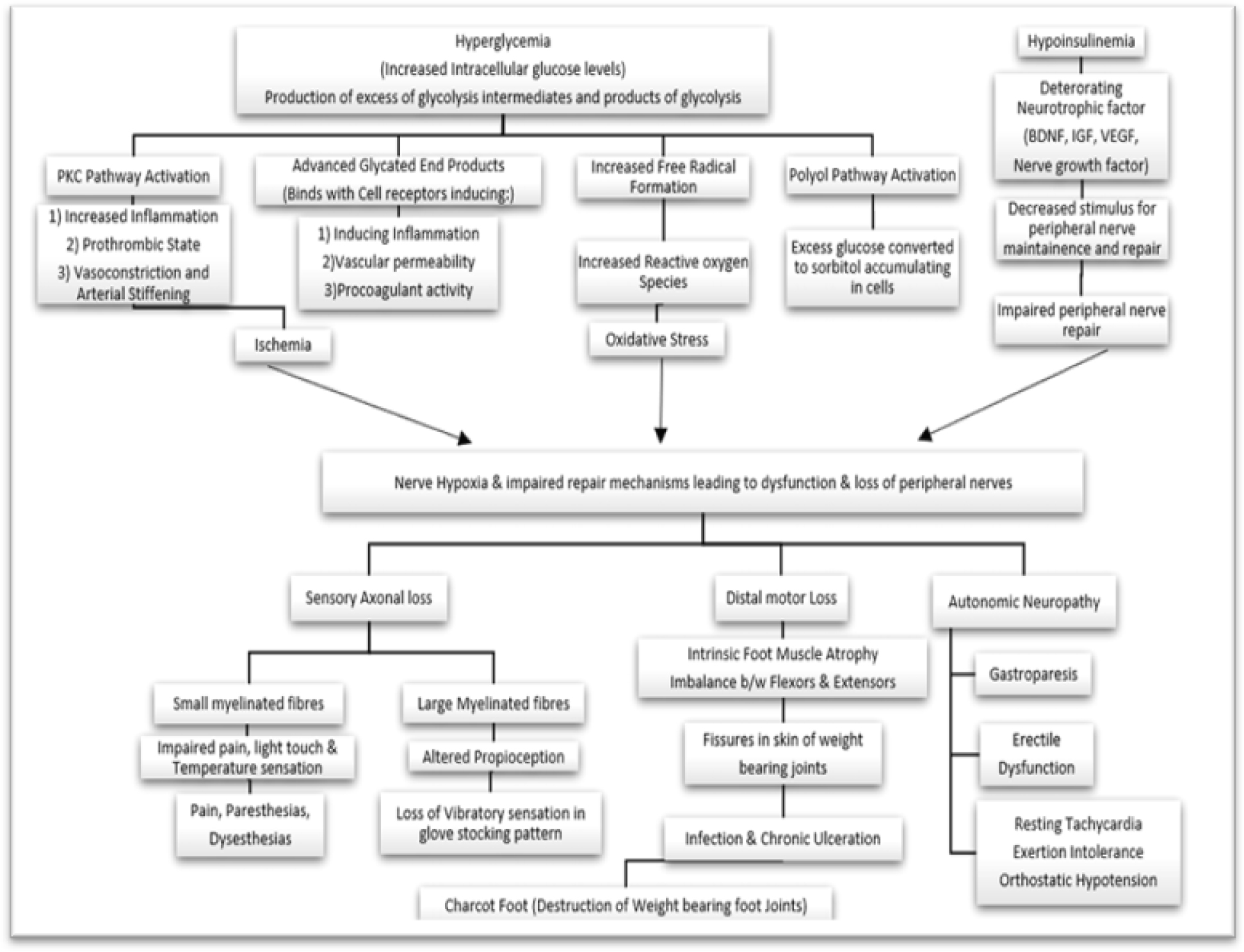
Figure 5:
Pathophysiology of diabetic neuropathy.
HPTLC analysis of the methanolic extract of Meha Mudgara Rasa revealed multiple phytoconstituents at varying concentrations (Figures 1–4, Tables 6–9). Chromatograms scanned at 245 nm and 366 nm presented diverse peaks and Rf values, which were compared to standards to identify key phytochemicals. The significant compounds detected include quercetin (Sousaet al., 2018), terpenes (Jainet al., 2013), flavonoids (World Health Organization, 2004), and coumarin (Maharaj and Rohan, 2013). These bioactive compounds are known for their anti-inflammatory, antioxidant, and analgesic properties, potentially contributing to reversing the pathophysiology of diabetic neuropathy.
The PKC pathway, which is influenced by vascular ischemia, inflammation, and oxidative stress, plays a key role in diabetic complications. Quercetin and terpenes enhance blood circulation, reducing ischemia, while quercetin also regulates AGE production. Inflammation is mitigated by quercetin and flavonoids through procytokine and IL inhibition. Additionally, quercetin improves mitochondrial function and reduces ROS, whereas flavonoids act as antioxidants, scavenging ROS to combat oxidative stress. These combined actions help reverse PKC pathway activation, positioning Meha Mudgara Rasa as a promising therapeutic for diabetic neuropathy (Figure 6).
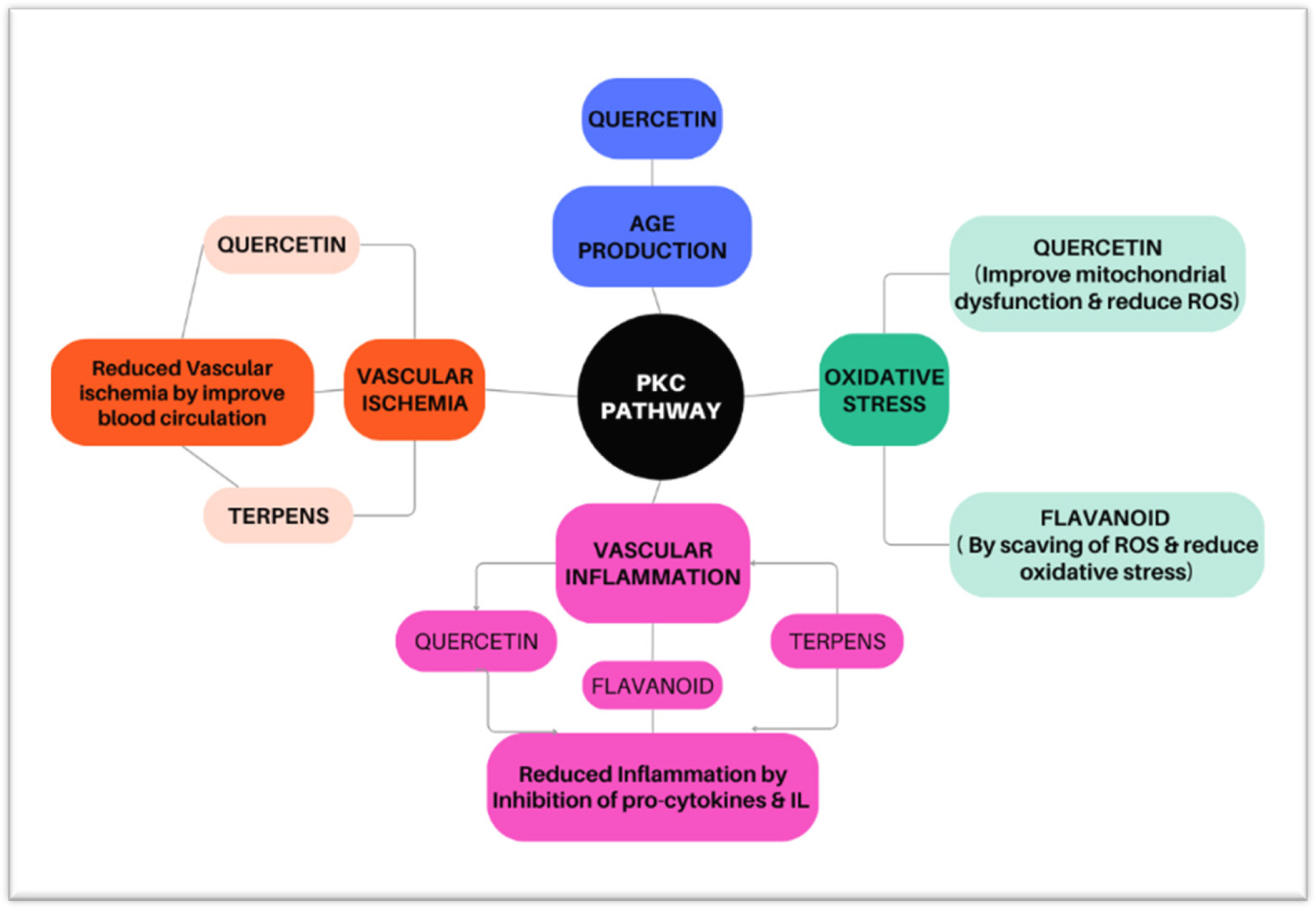
Figure 6:
Possible effects of Meha Mudgara Rasa on the Protein Kinase C signaling (PKC) pathway.
The second pathway known to cause DN is endothelial dysfunction and AGE production. Coumarin improves endothelial function and reduces blood viscosity, whereas quercetin and flavonoids combat oxidative stress by scavenging Reactive Oxygen Species (ROS). Additionally, coumarin alleviates vasculitis by inhibiting inflammatory markers, and terpenes aid in reducing ROS formation. Together, these compounds mitigate endothelial dysfunction, oxidative stress, and inflammation and promote vascular health and slow aging processes (Figure 7).
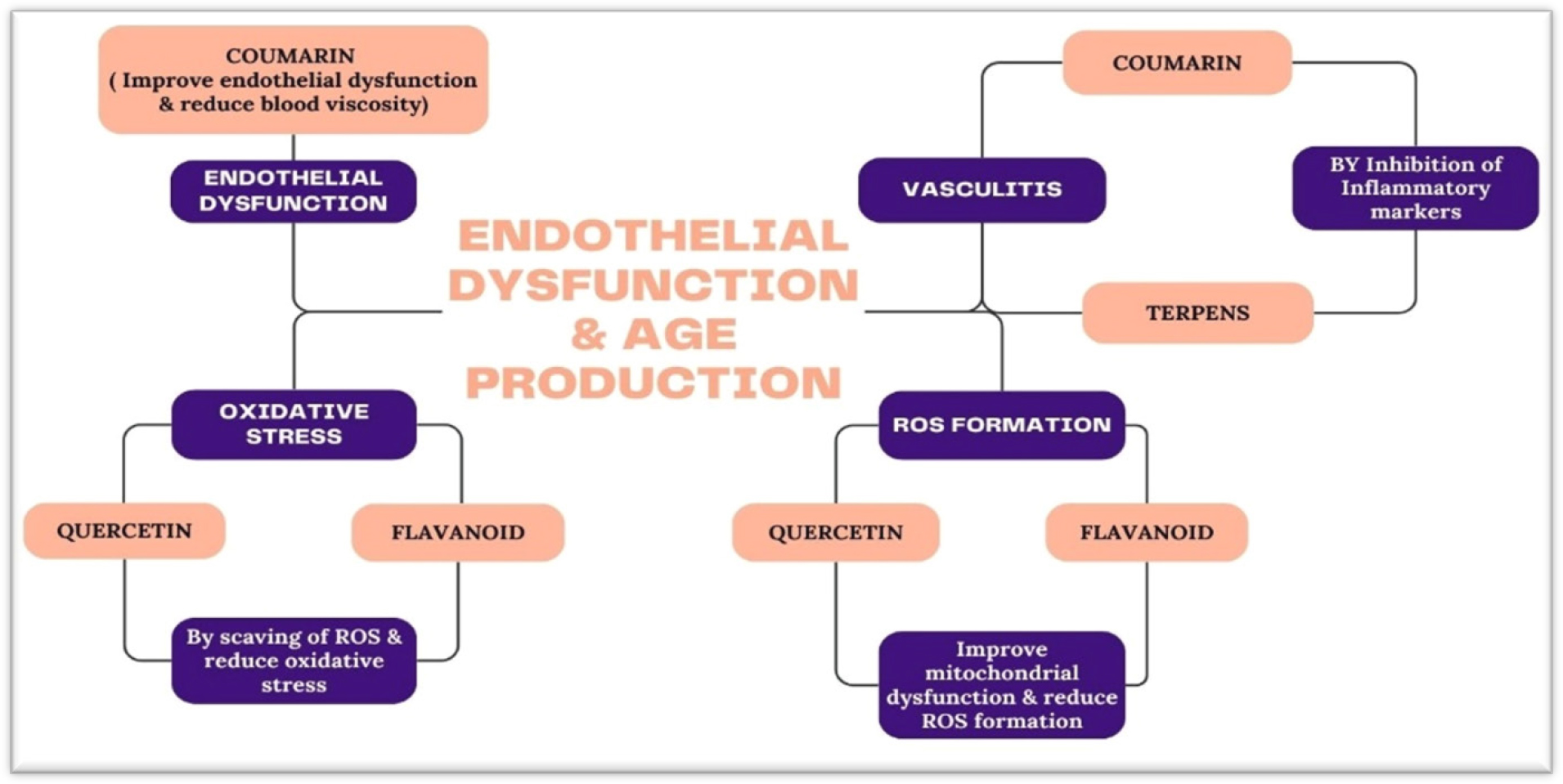
Figure 7:
Possible effects of Meha Mudgara Rasa on endothelial dysfunction and advanced glycation end products (AGEs).
Hypoinsulinemia leads to a disruption in nerve growth factors such as BDNF, IGF, VEGF, and NGF, which are essential for nerve regeneration and maintenance. This imbalance results in reduced nerve repair function, ultimately contributing to neuropathy. Flavonoids counteract this process by increasing nerve growth factor levels, thereby assisting in nerve repair and reducing neuropathic damage. Thus, flavonoids serve as crucial protective agents against nerve degeneration, promoting neuroprotection and functional recovery (Figure 8).
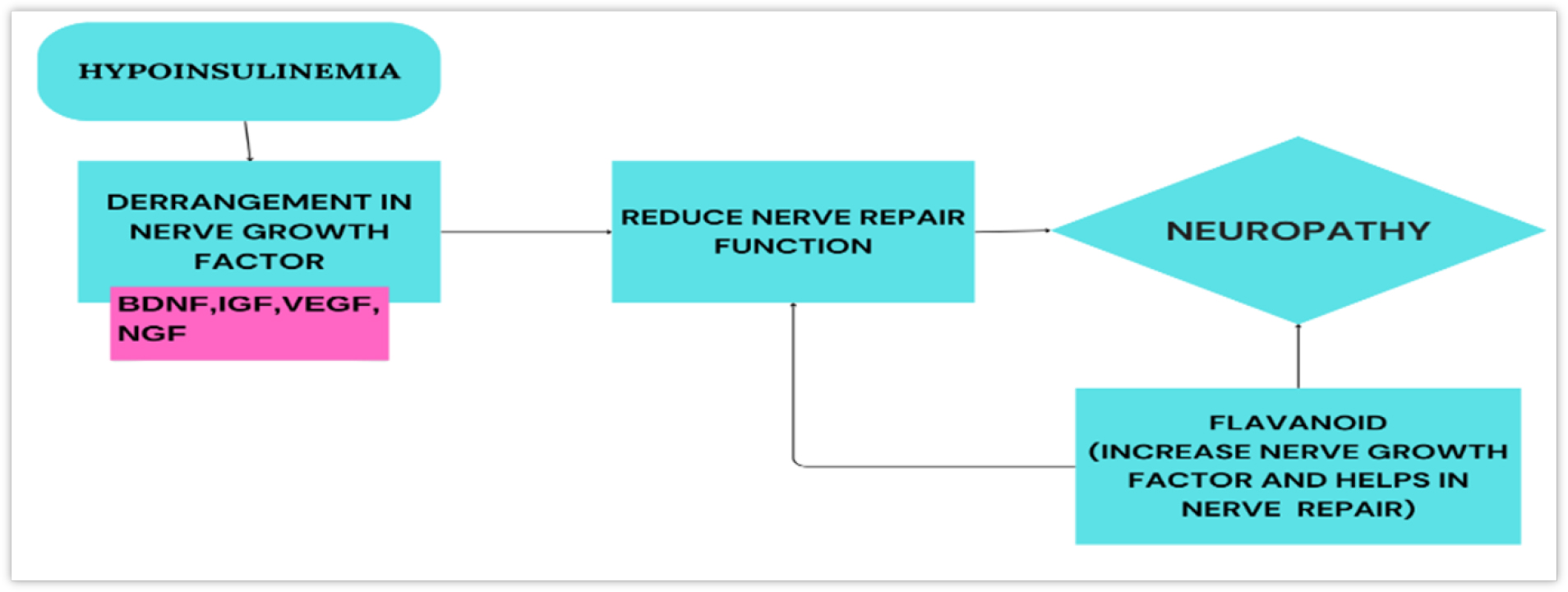
Figure 8:
Possible effects of Meha Mudgara Rasa on Hypoinsulinemia.
In addition, HPTLC also contains many other phytochemicals, such as umbelliferone (Ginwalaet al., 2019), myristicin (Gautam and Ramanathan, 2019). and stigmasterol (Wuet al., 2016). in relatively small quantities. These findings can help in the management of diabetes because of their antidiabetic and insulin-stimulating effects. It can mitigate hyperglycemia, which is a major cause of nerve damage in diabetic neuropathy. They are also reported to correct dyslipidemia, which can improve blood circulation and decrease the formation of atherosclerotic plaques in the arteries supplying the nerves, ultimately supporting better nerve function. These additional effects can help in conditions that are contributory but not directly associated with diabetic neuropathy.
CONCLUSION
Hence, the primary phytochemicals observed through HPTLC analysis of Meha Mudgara Rasa could be useful in the management of diabetes, peripheral neuronal disorders, peripheral vascular disorders, and inflammatory disorders. Further analyses, such as gas chromatography, liquid chromatography, and experimental and clinical studies, are necessary to substantiate the therapeutic potential of Meha Mudgara Rasa in diabetic neuropathy.
Cite this article:
Deshpande S, Gandhi M, Deshpande V. Postulation of Therapeutic Potential of Meha Mudgara Rasa in Management of Diabetic Neuropathy through High-Performance Thin Layer Chromatography (HPTLC) Analysis. J Young Pharm. 2025;17(3):581-91.
References
- Alharthy K. M., Balaha M. F., Devi S., Altharawi A., Yusufoglu H. S., Aldossari R. M, et al. (n.d.) Ameliorative effects of isoeugenol and eugenol against impaired nerve function in diabetic neuropathic rats. Google Scholar
- Ariya D., Kolesnikova Q., Xiong Q., Lodeiro S., Hua L., Matsuda S. P. T., et al. (n.d.) Lanosterol biosynthesis in plants. Google Scholar
- Bin Sayeed M. S., Karim S. M. R., Sharmin T., Morshed M. M.. (2016) Critical analysis on characterization, systemic effect, and therapeutic potential of Beta-sitosterol: A plant-derived orphan phytosterol. Medicines 3: 29 https://doi.org/10.3390/medicines3040029 | Google Scholar
- Caporali S., De Stefano A., Calabrese C., Giovannelli A., Pieri M., Savini I, et al. (n.d.) Anti-inflammatory and active biological properties of plant-derived bioactive compounds luteolin and luteolin-7-glucoside. https://doi.org/10.3390/medicines3040029 | Google Scholar
- de Sousa I. P., Sousa Teixeira M. V., Jacometti Cardoso Furtado N. A.. (2018) An overview of Biotransformation and toxicity of diterpenes. Molecules 23: 1387 https://doi.org/10.3390/molecules23061387 | Google Scholar
- Dhiman A., Sharma R., Singh R. K.. (2022) Target-based anticancer indole derivatives and insight into structure–activity relationship: A mechanistic review update (2018–2021). Acta Pharmaceutica Sinica. B 12: 3006-3027 https://doi.org/10.1016/j.apsb.2022.03.021 | Google Scholar
- Dhundhuk Nath, A. (n.d.) Rasendra Chintamani: Prameha Rogadhikar : 296-297 https://doi.org/10.1016/j.apsb.2022.03.021 | Google Scholar
- Gautam M., Ramanathan M.. (2019) Saponins of Tribulus terrestris attenuate neuropathic pain induced with vincristine through central and peripheral mechanisms. Inflammopharmacology 27: 761-772 https://doi.org/10.1007/s10787-018-0502-0 | Google Scholar
- Ginwala R., Bhavsar R., Chigbu D. I., Jain P., Khan Z. K.. (2019) Potential role of flavonoids in treating chronic inflammatory diseases with a special focus on anti-inflammatory activity of apigenin. Antioxidants 8: Article 35 https://doi.org/10.3390/antiox8020035 | Google Scholar
- Jahan H., Choudhary M. I., Atta A., Khan K. M., Ur-Rahman A.. (2018) Anthranilic acid derivatives: Novel inhibitors of protein glycation and the associated oxidative stress in hepatocytes. Medicinal Chemistry 14: 516-523 https://doi.org/10.2174/1573406413666171020120528 | Google Scholar
- Jain V., Pareek A., Bhardwaj Y. R., Singh N.. (2013) Attenuating effect of standardized fruit extract of Punica granatum L. in rat model of tibial and sural nerve transection-induced neuropathic pain. BMC Complementary and Alternative Medicine 13: 1-10 https://doi.org/10.1186/1472-6882-13-1 | Google Scholar
- Kamalakkannan N., Prince P.. (2004) Antidiabetic and antioxidant activity of Aegle marmelos extract in streptozotocin-induced diabetic rats. Pharmaceutical Biology 42: 125-130 https://doi.org/10.1080/13880200490510937 | Google Scholar
- Kim C., Lee J. H., Kim W., Li D., Kim Y., Lee K, et al. (n.d.) Suppressive effects of Cinnamomi Cortex and its phytocompound coumarin on oxaliplatin-induced neuropathic cold allodynia in rats. https://doi.org/10.1080/13880200490510937 | Google Scholar
- Kumar S., Pandey A. K.. (Array) Chemistry and biological activities of flavonoids: An overview. TheScientificWorldJournal : Article 162750 https://doi.org/10.1155/2013/162750 | Google Scholar
- Lin Z., Cheng X., Zheng H.. (2023) Umbelliferon: A review of its pharmacology, toxicity, and pharmacokinetics. Inflammopharmacology 31: 1731-1750 https://doi.org/10.1007/s10787-023-01256-3 | Google Scholar
- Motilal S., Maharaj R. G.. (2013) Nutmeg extracts for painful diabetic neuropathy: A randomized, double-blind, controlled study. Journal of Alternative and Complementary Medicine 19: 347-352 https://doi.org/10.1089/acm.2012.0016 | Google Scholar
- Muruganathan U., Srinivasan S.. (n.d.) Beneficial effect of carvone, a dietary monoterpene, ameliorates hyperglycemia by regulating key enzyme activities of carbohydrate metabolism in streptozotocin-induced diabetic rats. https://doi.org/10.1089/acm.2012.0016 | Google Scholar
- Resham K., Khare P., Bishnoi M., Sharma S. S.. (2020) Neuroprotective effects of isoquercitrin in diabetic neuropathy via Wnt/β-catenin signaling pathway inhibition. BioFactors 46: 411-420 https://doi.org/10.1002/biof.1615 | Google Scholar
- Russo R., Ciociaro A., Berliocchi L., Cassiano M. G. V., Rombolà L., Ragusa S., Bagetta G., Blandini F., Corasaniti M. T., et al. (2013) Implication of limonene and linalyl acetate in cytotoxicity induced by bergamot essential oil in human neuroblastoma cells. Fitoterapia 89: 48-57 https://doi.org/10.1016/j.fitote.2013.05.014 | Google Scholar
- Sivakumar P. M., Prabhakar P. K., Cetinel S., R N., Prabhawathi V.. (2022) Molecular insights on the therapeutic effect of selected flavonoids on diabetic neuropathy. Mini Reviews in Medicinal Chemistry 22: 1828-1846 https://doi.org/10.2174/1389557522666220309140855 | Google Scholar
- Suryavanshi S. V., Barve K., Addepalli V., Utpat S. V., Kulkarni Y. A.. (2021) Triphala Churna-A traditional formulation in Ayurveda mitigates diabetic neuropathy in rats. Frontiers in Pharmacology 12: Article 662000 https://doi.org/10.3389/fphar.2021.662000 | Google Scholar
- Tian M.-M., Li Y.-X., Liu S., Zhu C.-H., Lan X.-B., Du J., Ma L., Yang J.-M., Zheng P., Yu J.-Q., Liu N., et al. (2021) Glycosides for peripheral neuropathic pain: A potential medicinal components. Molecules 27: Article 255 https://doi.org/10.3390/molecules27010255 | Google Scholar
- Tripathi A. K., Ray A. K., Mishra S. K.. (2022) Molecular and pharmacological aspects of piperine as a potential molecule for disease prevention and management: Evidence from clinical trials. Beni-Suef University Journal of Basic and Applied Sciences 11: 16 https://doi.org/10.1186/s43088-022-00196-1 | Google Scholar
- World Health Organization. (2004) Guidelines on safety monitoring of pharmacovigilance herbal medicines in systems. World Health Organization. https://doi.org/10.1186/s43088-022-00196-1 | Google Scholar
- Wu F., Kerčmar P., Zhang C., Stöckigt J.. (2016) Sarpagan-Ajmalan-type indoles: Biosynthesis, structural biology, and chemo-enzymatic significance. The Alkaloids. Chemistry and Biology 76: 1-61 https://doi.org/10.1016/bs.alkal.2015.10.001 | Google Scholar
- Zhang S., Won Y.-K., Ong C.-N., Shen H.-M.. (2005) Anticancer potential of sesquiterpene lactones. Current Medicinal Chemistry. Anti-Cancer Agents 5: 239-249 https://doi.org/10.2174/1568011053765976 | Google Scholar
- Zhang X., Wang J., Zhu L., Wang X., Meng F., Xia L., Zhang H., et al. (2022) Advances in stigmasterol on its anti-tumor effect and mechanism of action. Frontiers in Oncology 12: Article 1101289 https://doi.org/10.3389/fonc.2022.1101289 | Google Scholar
- Zhang Y., Liu Y., Li Q., Wang X. D., Zheng X. B., Yang B. L, et al. (2018) 1,8-cineole decreases neuropathic pain via P2X3 receptor in the dorsal root ganglion. Neurochemistry International 121: 20-25 https://doi.org/10.3389/fonc.2022.1101289 | Google Scholar
- Zhao B., Zhang Q., Liang X., Xie J., Sun Q.. (2021) Quercetin reduces inflammation in a rat model of diabetic peripheral neuropathy by regulating the TLR4/MyD88/NF-κB signaling pathway. European Journal of Pharmacology 912: Article 174604 https://doi.org/10.1016/j.ejphar.2021.174604 | Google Scholar
